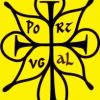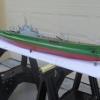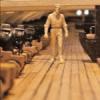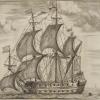-
Posts
1,222 -
Joined
-
Last visited
Reputation Activity
-
 jbshan got a reaction from Bindy in Maximum length of a deck plank
jbshan got a reaction from Bindy in Maximum length of a deck plank
Certainly they needed long straight pieces for masts and keels, etc., oak, elm or beech for keels, pines for masts. Both France and England would have needed imported pines of those sizes, mostly Baltic, though England had sources in America until the late unpleasantness beginning in 1775, thereafter Canada, and France had sources in Europe and the Med. I don't think the French took advantage of their North American possessions for timber nearly as much; they were more interested in furs. Possibly an offcut from one of those keel or mast pieces might be used for planking somewhere. A short distance *to water* would be desirable. Once they could get a big timber onto a boat or barge it got a lot easier.
They could have, but would they have? Perhaps strakes next to the hatches, under the guns, or other 'binding strakes' would have been advantaged by long lengths. If Boudriot gives a generally shorter length, I would go with him. He did the research and wrote the books.
-
 jbshan got a reaction from mtaylor in Maximum length of a deck plank
jbshan got a reaction from mtaylor in Maximum length of a deck plank
Certainly they needed long straight pieces for masts and keels, etc., oak, elm or beech for keels, pines for masts. Both France and England would have needed imported pines of those sizes, mostly Baltic, though England had sources in America until the late unpleasantness beginning in 1775, thereafter Canada, and France had sources in Europe and the Med. I don't think the French took advantage of their North American possessions for timber nearly as much; they were more interested in furs. Possibly an offcut from one of those keel or mast pieces might be used for planking somewhere. A short distance *to water* would be desirable. Once they could get a big timber onto a boat or barge it got a lot easier.
They could have, but would they have? Perhaps strakes next to the hatches, under the guns, or other 'binding strakes' would have been advantaged by long lengths. If Boudriot gives a generally shorter length, I would go with him. He did the research and wrote the books.
-
 jbshan got a reaction from Canute in Maximum length of a deck plank
jbshan got a reaction from Canute in Maximum length of a deck plank
Certainly they needed long straight pieces for masts and keels, etc., oak, elm or beech for keels, pines for masts. Both France and England would have needed imported pines of those sizes, mostly Baltic, though England had sources in America until the late unpleasantness beginning in 1775, thereafter Canada, and France had sources in Europe and the Med. I don't think the French took advantage of their North American possessions for timber nearly as much; they were more interested in furs. Possibly an offcut from one of those keel or mast pieces might be used for planking somewhere. A short distance *to water* would be desirable. Once they could get a big timber onto a boat or barge it got a lot easier.
They could have, but would they have? Perhaps strakes next to the hatches, under the guns, or other 'binding strakes' would have been advantaged by long lengths. If Boudriot gives a generally shorter length, I would go with him. He did the research and wrote the books.
-
 jbshan got a reaction from rybakov in Deck planking and how to show 'caulking'
jbshan got a reaction from rybakov in Deck planking and how to show 'caulking'
Soft pencil on one edge and one end of each plank for me. It has variety from place to place and is subtle generally.
As far as fasteners, check the scale very carefully. A nail head would be maybe 1/8". On the quarterdeck and officers' country the nail holes would be plugged with a small chip of wood, diamond shaped, and with the grain matching the plank. Practically invisible even if you were standing on the actual deck.
-
 jbshan got a reaction from Doreltomin in Seeking information on determining load waterline
jbshan got a reaction from Doreltomin in Seeking information on determining load waterline
While she did indeed capsize and fill through the ports, Mary Rose was some 25 years old at her sinking, so not that totally unsuccessful of a design. Just to keep the record straight.
-
 jbshan got a reaction from mtaylor in Deck planking and how to show 'caulking'
jbshan got a reaction from mtaylor in Deck planking and how to show 'caulking'
Soft pencil on one edge and one end of each plank for me. It has variety from place to place and is subtle generally.
As far as fasteners, check the scale very carefully. A nail head would be maybe 1/8". On the quarterdeck and officers' country the nail holes would be plugged with a small chip of wood, diamond shaped, and with the grain matching the plank. Practically invisible even if you were standing on the actual deck.
-
 jbshan got a reaction from Piet in Muscongus Bay Lobster Smack by Greg Springs - FINISHED - Midwest Products - first build
jbshan got a reaction from Piet in Muscongus Bay Lobster Smack by Greg Springs - FINISHED - Midwest Products - first build
Before you try it again, open up the slot just a smidge so you don't have to force it, just snug. White or yellow glue will wet and swell the wood enough to make it tight again when you do the final assembly.
-
 jbshan got a reaction from druxey in Seeking information on determining load waterline
jbshan got a reaction from druxey in Seeking information on determining load waterline
They put into the specs where they *wanted* the ship to float, but if wishes were horses ...
-
 jbshan got a reaction from avsjerome2003 in how to work with teeny blocks???
jbshan got a reaction from avsjerome2003 in how to work with teeny blocks???
I like the fly tying vise, might get one of those.
A friend set me up with needle nose tweezers mounted to a third-hand work stand. Clamp the block in there and position where you can get to everything. Radio Shack has small all-copper alligator clips. Pass the line around the block to where both ends come out towards you. Apply the alligator clip, pulling the two ends up tight. Using thin line (thread) between the clip and block tie a series of half hitches around the pair of 'tails' until they are secure (usually four hitches suffice). Put a drop of glue on (please not CA) and you can take the clip off. Combine that with whatever sort of thimble, hook, pendant, tackle you need and you should be good to go.
This is about a 1/8" block, I have done down to 3mm.
-
 jbshan got a reaction from druxey in How odd was the bowsprit support of the 1763 Cutter Sherbourne?
jbshan got a reaction from druxey in How odd was the bowsprit support of the 1763 Cutter Sherbourne?
'Cutter' as a rig type implies the bowsprit could be extended for larger sails. 'Cutter' as vessel type is more of a dispatch vessel, fast, nimble, large sail area for the size of the hull. The Sherbourne drawing looks as if it is a shifting bowsprit. Some of the other examples do as well, there are two with an additional 'fid' hole forward of the bitts, and several look as if there would be clearance above the bitts for the bowsprit to shift aft, as does Alert.
(Aside) If nothing else, those pics show there is more than one way to skin that cat. No two alike, are there?
-
 jbshan got a reaction from tkay11 in How odd was the bowsprit support of the 1763 Cutter Sherbourne?
jbshan got a reaction from tkay11 in How odd was the bowsprit support of the 1763 Cutter Sherbourne?
'Cutter' as a rig type implies the bowsprit could be extended for larger sails. 'Cutter' as vessel type is more of a dispatch vessel, fast, nimble, large sail area for the size of the hull. The Sherbourne drawing looks as if it is a shifting bowsprit. Some of the other examples do as well, there are two with an additional 'fid' hole forward of the bitts, and several look as if there would be clearance above the bitts for the bowsprit to shift aft, as does Alert.
(Aside) If nothing else, those pics show there is more than one way to skin that cat. No two alike, are there?
-
 jbshan got a reaction from Johncclark in Mayflower Mystery Project by Cabrillo - FINISHED - RESTORATION
jbshan got a reaction from Johncclark in Mayflower Mystery Project by Cabrillo - FINISHED - RESTORATION
Generally, I would suggest cleaning, restoring the rigging as far as you can determine it was originally installed, and to the same level of sophistication, and basically returning a refurbished piece of folk art to its owner. Otherwise you might as well buy a current Mayflower kit and go that route.
I think to go further would be a big heart breaker.
-
 jbshan reacted to wefalck in How much detail is too much
jbshan reacted to wefalck in How much detail is too much
For me there is only one rule: reproduce the prototype as well as you can within the limits of materials' sizes and their workability (and of course your skills). Detail only appears too much and overcrowding, if they are done overscale (for whatever materials or skills reasons). The conclusion from this could well be not to include a certain detail, because it cannot be reproduced adequately.
-
 jbshan got a reaction from Chuck Seiler in 74 Gun Ship Complete Framing Supplemental Plans
jbshan got a reaction from Chuck Seiler in 74 Gun Ship Complete Framing Supplemental Plans
A two-car garage ought to be big enough to still be able to have something in build after you have this one on display. You don't want to be cramped. Do be careful going back and forth between plans sets. The books (4 vol. set) are in French feet, as I understand it.
-
 jbshan got a reaction from mtaylor in 74 Gun Ship Complete Framing Supplemental Plans
jbshan got a reaction from mtaylor in 74 Gun Ship Complete Framing Supplemental Plans
A two-car garage ought to be big enough to still be able to have something in build after you have this one on display. You don't want to be cramped. Do be careful going back and forth between plans sets. The books (4 vol. set) are in French feet, as I understand it.
-
 jbshan reacted to Chuck Seiler in 74 Gun Ship Complete Framing Supplemental Plans
jbshan reacted to Chuck Seiler in 74 Gun Ship Complete Framing Supplemental Plans
Which project do you start first? The model or the room addition used to store the model?
-
 jbshan got a reaction from mtaylor in Thinking things trough, the gunport lids
jbshan got a reaction from mtaylor in Thinking things trough, the gunport lids
Thanks, Daniel. I have a dime the size of a manhole cover that can be confusing to some people. I see what you're saying.
Interesting that Longridge shows top hinges and Goodwin working a little later shows forward hinges. Presumably both had the same source, although perhaps Trincomalee or Unicorn entered in there somewhere, if not a source for authors, as a source for restorers.
-
 jbshan got a reaction from dafi in Thinking things trough, the gunport lids
jbshan got a reaction from dafi in Thinking things trough, the gunport lids
Thanks, Daniel. I have a dime the size of a manhole cover that can be confusing to some people. I see what you're saying.
Interesting that Longridge shows top hinges and Goodwin working a little later shows forward hinges. Presumably both had the same source, although perhaps Trincomalee or Unicorn entered in there somewhere, if not a source for authors, as a source for restorers.
-
 jbshan reacted to dafi in Thinking things trough, the gunport lids
jbshan reacted to dafi in Thinking things trough, the gunport lids
That is my Tic-Tac, man :-)
As many countries do not know the size of different coins of other ones - they vary largely in between the countries and values - the Tic-Tac is standardized so it gives a good scale for all countries.
:-)
Cheers, Daniel
-
 jbshan got a reaction from dafi in Thinking things trough, the gunport lids
jbshan got a reaction from dafi in Thinking things trough, the gunport lids
Just to make sure we go totally off topic, what is that white oval shape on top of the coin in the first pic? I have seen something similar in a few other posts.
-
 jbshan got a reaction from dafi in Thinking things trough, the gunport lids
jbshan got a reaction from dafi in Thinking things trough, the gunport lids
The best I've seen is 'Construction and Fitting', Peter Goodwin. He shows a solid scuttle lid that is the same thickness as the port lid. It is secured inboard with the sliding deadbolt in dafi's post #4, bottom picture. This should not be surprising since Goodwin was Curator of Victory and the pic is of Victory. Goodwin says this is the original style, that later scuttles had glass. Perhaps the kit scuttle lids are intended to represent this later style.
-
 jbshan reacted to druxey in Windlass on 1815 Revenue cutter
jbshan reacted to druxey in Windlass on 1815 Revenue cutter
A windlass of about 1815 on a small vessel would be worked by short capstan-style bars called normans. It would look like the one Chuck Passaro sells on the Syren Ship Model Company's site.
-
 jbshan got a reaction from trippwj in Seeking information on determining load waterline
jbshan got a reaction from trippwj in Seeking information on determining load waterline
The formula lehmann gives is very close to the ancient formulas used for tonnage (cargo capacity).
-
 jbshan got a reaction from mattsayers148 in The Kit-Basher's Guide To The Galaxy
jbshan got a reaction from mattsayers148 in The Kit-Basher's Guide To The Galaxy
Don't worry about me going off topic again. I already removed about six posts of mine from a thread where the original question was not what the questioner wanted an answer to.
-
 jbshan got a reaction from CaptainSteve in The Kit-Basher's Guide To The Galaxy
jbshan got a reaction from CaptainSteve in The Kit-Basher's Guide To The Galaxy
Or needle threader. It's a coin-sized disc with a tiny wire loop out one side. Slide the loop through a hole which collapses it, then it opens up once through. Put your line in the loop and pull back through.














